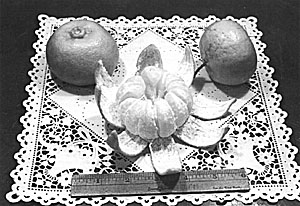
| Mandarin is a group name for a class of oranges with thin, loose peel, which have been dubbed "kid-glove" oranges. These are treated as members of a distinct species, Citrus reticulata Blanco. The name "tangerine" could be applied as an alternate name to the whole group, but, in the trade, is usually confined to the types with red-orange skin. In the Philippines all mandarin oranges are called dalangh (from the Spanish naranjita) or dalandan. Spanish-speaking people in the American tropics call them mandarina. The mandarin tree may be much smaller than that of the sweet orange or equal in size, depending on variety. With great age, some may reach a height of 25 ft (7.5 m) with a greater spread. The tree is usually thorny, with slender twigs, broad-or slender-lanceolate |  |
The mandarin orange is considered a native of south-eastern Asia and the Philippines. It is most abundantly grown in Japan, southern China, India, and the East Indies, and is esteemed for home consumption in Australia. It gravitated to the western world by small steps taken by individuals interested in certain cultivars. Therefore, the history of its spread can be roughly traced in the chronology of separate introductions. Two varieties from Canton were taken to England in 1805. They were adopted into cultivation in the Mediterranean area and, by 1850, were well established in Italy. Sometime between 1840 and 1850, the 'Willow-leaf' or 'China Mandarin' was imported by the Italian Consul and planted at the Consulate in New Orleans. It was carried from there to Florida and later reached California. The 'Owari' Satsuma arrived from Japan, first in 1876 and next in 1878, and nearly a million budded trees from 1908 to 1911 for planting in the Gulf States. Six fruits of the 'King' mandarin were sent from Saigon in 1882 to a Dr. Magee at Riverside, California. The latter sent 2 seedlings to Winter Park, Florida. Seeds of the 'Oneco' mandarin were obtained from India by the nurseryman, P.W. Reasoner, in 1888. In 1892 or 1893, 2 fruits of 'Ponkan' were sent from China to J.C. Barrington of McMeskin, Florida, and seedlings from there were distributed and led to commercial propagation. Mandarin oranges are much more cold-hardy than the sweet orange, and the tree is more tolerant of drought. The fruits are tender and readily damaged by cold.
Mandarin essential oil and Petitgrain oil and tangerine oil, and their
various tinctures and essences, are valued in perfume-manufacturing, particularly
in the formulation of floral compounds and colognes. They are produced
mostly in Italy, Sicily and Algiers.